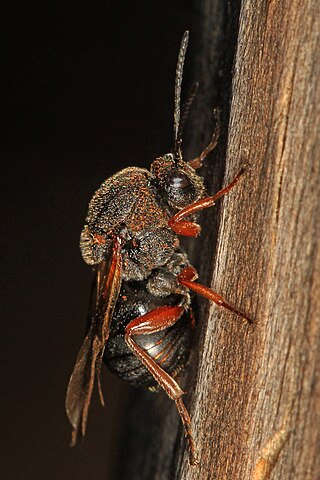
Gall wasps, also traditionally calledgallflies, are hymenopterans of the family Cynipidae in the wasp superfamily Cynipoidea. Their common name comes from the galls they induce on plants for larval development. About 1,300 species of this generally very small creature are known worldwide, with about 360 species of 36 different genera in Europe and some 800 species in North America.

Neuroterus is a genus of gall wasps that induce galls on oaks in which the wasp larvae live and feed. Some species produce galls that fall off the host plant and 'jump' along the ground due to the movement of the larvae within.
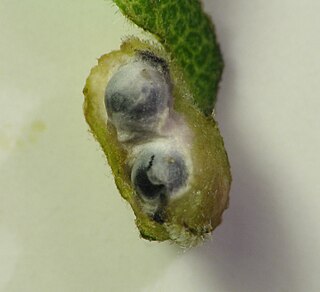
Galeopsomyia is a New World genus of hymenopteran insects of the family Eulophidae. The genus is a hyperparasitoid of other gall-inducing wasps of the genera Eurytoma and Torymus.

Cynips quercusfolii, also known as the cherry gall wasp, is a gall wasp species in the genus Cynips and family Cynipidae. The species is important for the production of commercial nutgall formed on Quercus lusitanica . Galls are located on the underside of leaves, with the majority of galls being on the second and third veins from the petiole of the leaf.

Andricus quercuscalifornicus, or the California gall wasp, is a small wasp species that induces oak apple galls on white oaks, primarily the valley oak but also other species such as Quercus berberidifolia. The California gall wasp is considered an ecosystem engineer, capable of manipulating the growth of galls for their own development. It is found from Washington, Oregon, and California to northern regions of Mexico. Often multiple wasps in different life stages occupy the same gall. The induced galls help establish complex insect communities, promoting the diversification in niche differentiation. Furthermore, the adaptive value of these galls could be attributed their ecological benefits such as nutrition, provision of microenvironment, and enemy avoidance.

Trichagalma formosana is a gall wasp species in the family Cynipidae whose life cycle involves only Palaearctic oaks, Quercus subgen. Quercus, in the section Cerris. It is endemic to Taiwan.
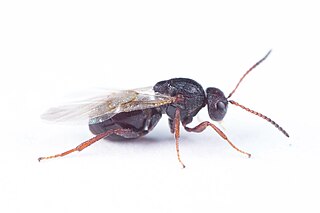
Bassettia is a genus of gall wasps found in North America.
Bassettia pallida is a species of gall wasp found in the Southern United States. This species was described by American entomologist William Harris Ashmead in 1896. B. pallida reproduces asexually in galls it induces on oak trees. The parasite Euderus set, a eulophid wasp, has B. pallida as a host and manipulates its behavior.
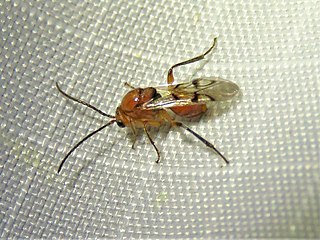
Belonocnema is a genus of oak gall wasps in the family Cynipidae, found in the United States from Texas, east to Florida. All species induce galls on section Virentes oaks and have both sexual and asexual generations. The asexual generation galls form as small balls on the underside of leaves, and the sexual galls form on roots. A number of inquiline, parasitoid, and hyperparasitoid wasp species have been reared from Belonocnema galls.

Diplolepis ignota is a species of gall wasp (Cynipidae). Galls in which the larvae live and feed are formed on the leaves of several species of wild rose (Rosa). Individual galls are single-chambered and spherical, but multiple galls can coalesce into irregularly rounded galls.

Andricus dimorphus, also called the clustered midrib gall wasp, is a species of oak gall wasp in the family Cynipidae. Galls in which the larvae live and feed are formed in clusters along the midrib on the underside of oak leaves.
Synergus japonicus is a species of gall wasp in the family Cynipidae. Whereas most gall wasps create the galls in which they live, Synergus japonicus is an inquiline species, living in the gall created by another species of wasp. It is native to Japan, China and Russia.
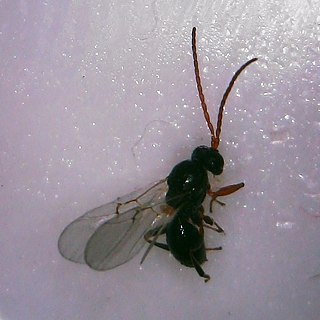
Andricus quercuspetiolicola, also called the oak petiole gall wasp, is a species of oak gall wasp in the family Cynipidae. Galls in which the larvae live and feed are formed along the midrib or petiole of white oak leaves.

Disholcaspis quercusmamma, the oak rough bulletgall wasp, is a species of gall wasp in the family Cynipidae. The quercus in its name is the genus name for oak, while "mamma" is Latin for "breast", presumably a reference to the "nipple" on the gall.

Phylloteras volutellae, the conical oak gall wasp, is a species of gall wasp , tribe Cynipini , found in North America.
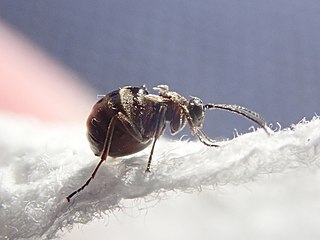
Acraspis quercushirta, the jewel oak gall wasp, is a species of gall wasp in the family Cynipidae, tribe Cynipini, found in North America.

Druon quercuslanigerum is a species of gall wasp that forms galls on Quercus virginiana, Quercus geminata, Quercus fusiformis, and Quercus oleoides. There are both asexual and sexual generations. The asexual generation forms galls on the leaves whereas the sexual generation forms galls on the catkins. It can be found in the southern United States and Mexico. Predators of this species include the green parakeet.

Belonocnema treatae is a species of gall wasp that forms galls on Quercus virginiana and very rarely Quercus geminata. There are both asexual and sexual generations. The asexual generation forms galls on the underside of leaves while the sexual generation form galls on the roots. This species can be found in the United States, where it is known from Alabama, Florida, Georgia, Mississippi, North Carolina, and South Carolina. It, along with the other described Belonocnema species, has been used to study speciation.
Andricus hispanicus is a parthenogenetic species of wasp which causes the formation of marble galls on oak trees. The galls caused by the agamous generation are similar to the closely related Andricus kollari.

Belonocnema fossoria is a species of gall wasp that forms galls on Quercus geminata. There are both asexual and sexual generations. The asexual generation forms galls on the underside of leaves whereas the sexual generation form galls on the roots. It can be found in the United States, where it is known from Georgia and Florida. It, along with the other described Belonocnema species, have been used to study speciation.


















